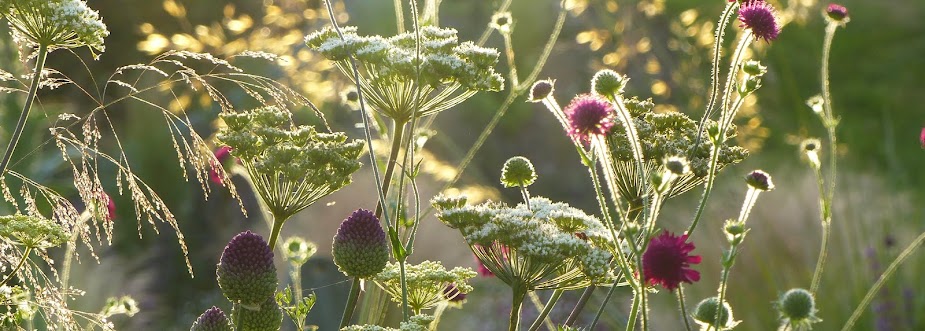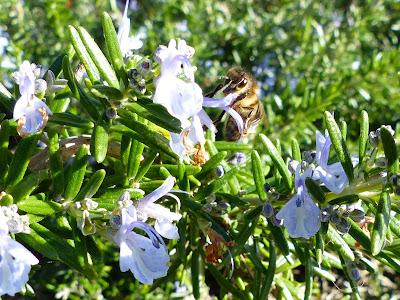A few photos of the bees in the garden today (25.9 deg.C here today and there is the scent of honey in the air), a few swarm photos and a few photos taken in the spring.... An overdue bee-update!
Honeybee on Inula hookeri today, July 19th.
Honeybee en-route to Sweetpea.
July 19th
The honey bees have been all over the Stachys byzantina / Lambs ears.
The Rosebay Willowherb in the edible-woodland garden is a flower-forest ...

...thrumming with bees. July 19th.
.... is a mass of blossom covered in honeybees, bumblebees and hoverflies July 19th.
Our first swarm this year was on May 27th.
Here they are arriving in the new home of their choice on May28th.
This is another swarm on June 12th.
Moving themselves into a bait hive placed on the picnic bench at the deck.
The bait hive is a small light portable hive with some old brood comb inside to attract a swarm.
Once all the bees are settled into the bait hive...
...the bait hive can be moved to the location of their final home.
It was one month later, on July 12th, before I found a suitable day to transfer this same colony of bees into their permanent hive.
They had been busy raising brood and building comb, time yet to gather honey for the winter.
The swarms this year have been abundant and we have been able to share swarms.
Thankfully we are at home to see the emerging swarms and collect them, as well as having the back-up bait hives.
-------------------------
Thankfully we are at home to see the emerging swarms and collect them, as well as having the back-up bait hives.
-------------------------
Wild Pear blossom, April 14th.
Viburnum x Carlcephalum?
Winter arrived late and lingered on, but all the colonies made it through. We had a little snow and plenty of hail in April, but the bees made the best of it and so did I. Pottering in the garden, cutting back, moving, dividing, planting, potting on, much of the time with the bees buzzing about nearby. Only occasionally do I stop and take out the camera to take pictures, So these are just a few of their spring plants this year....
Winter arrived late and lingered on, but all the colonies made it through. We had a little snow and plenty of hail in April, but the bees made the best of it and so did I. Pottering in the garden, cutting back, moving, dividing, planting, potting on, much of the time with the bees buzzing about nearby. Only occasionally do I stop and take out the camera to take pictures, So these are just a few of their spring plants this year....
Viburnum x Carlcephalum? April 10th.
Osmanthus Delavayi and a big orange pollen sack on this honeybee, April 10th.
Pollinating the Victoria plums, April 10th.
Apricot blossom, they haven't cropped so well this year though, at least it is not from lack of pollination!
The Rosemary was covered in bees during any half decent weather while it flowered between October and May. In our garden it is the best and longest flowering winter /spring bee plant. Photo February 23rd.
Erysimum Bowles mauve flowered all winter long, it flowers all spring, summer and autumn too, (I admit I am actually starting to tire of its endless flowering! I chopped a couple of plants right back, this will encourage more flowers but there may be time for their absence to renew my favour! ). The first honeybee visits that I saw to the Eriysimum were on February 23rd and have continued intermittently since.
Honeybee on willow February 23rd.
Willow, a super source of pollen for the bees in spring, when the weather is not windy.
That completes our bee update from early spring to summer!
That completes our bee update from early spring to summer!





























